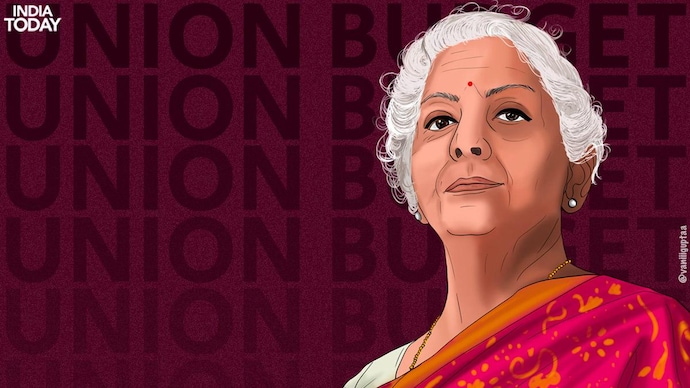[ad_1]
Finance Minister Nirmala Sitharaman will present the Union Budget 2023 at a time when the Indian economy is facing sustained pressure from the worsening global economic slowdown. Her task will be even more challenging as it will be the government’s last full-fledged budget before the general elections in 2024. Will she succeed in balancing the act?

Finance Minister Nirmala Sitharaman is expected to focus on long-term growth and fiscal consolidation. (Illustration by Vani Gupta/India Today)
The general elections in 2024 and the impact of the worsening global economic slowdown on India are two challenges that will make the Union Budget 2023 a tricky affair for the government.
While Finance Minister Nirmala Sitharaman is not new to presenting budgets under challenging situations – having steered the economy safely through two devastating years of the Covid-19 pandemic – the circumstances under which she takes centre stage to announce her fifth budget are drastically different.
Saving the economy
India’s economy had been sailing smoothly during the first half of the ongoing financial year after fully getting rid of the post-pandemic hangover. But a global economic slowdown triggered by multiple factors gave it a fresh headache in terms of growth.
ALSO READ | Union Budget 2023: How govt can boost Indian economy amid global slowdown
A strong rebound in private consumption saved the Indian economy this year, but signs of a demand slowdown are already visible, as highlighted by companies from various sectors in their respective December quarter results.
Experts believe that consumption and investments could further slowdown in FY24 amid growing fears of a recession in the West, more job cuts across industries and sustained inflation.
The government is aware of the brewing economic challenges, and Nirmala Sitharaman knows the importance of ditching populism to focus on announcements aimed at long-term growth, lowering the fiscal deficit, and most importantly, shielding the economy from external shocks.
To achieve this, experts believe the finance minister will announce measures to support rural economic growth, boost allocation in job-oriented sectors like infrastructure and manufacturing, and cut spending on subsidies. Small MSMEs and startups could also see favourable announcements in the budget as the government wants to boost local manufacturing and increase tariffs to reduce imports.
Several experts have also recommended the government to stick to its path of fiscal consolidation and create a pipeline for long-term growth, instead of temporary relief measures.
ALSO READ | Budget 2023: Top economist says focus should be on long-term growth, fiscal prudence
But safeguarding the economy is just one part of the challenge for the government, given that it is the government’s last full-fledged budget before the Lok Sabha elections in 2024.
Will populism trump economic challenges?
Over its two consecutive tenures, the BJP-led NDA government has cemented its position as a dominant force in India’s political spectrum. The government’s ongoing tenure, particularly, has been marked by high inflation, slower growth, rising unemployment and falling income.
But that has hardly diminished its political capital, with a recent India Today Mood of the Nation Survey showing that the BJP government would secure a resounding victory had polls been held in January.
ALSO READ | Will it be a populist and prudent Budget?
The survey showed that 67 per cent of respondents were ‘satisfied’ with the current government’s performance, including handling of the economy. Moreover, 54 per cent of the respondents find the BJP-led NDA government’s handling of the economy to be good.
This indicates that the government’s pro-poor policies, social reforms and focus on infrastructure and manufacturing-driven growth have struck a chord with citizens, gaining their trust even in the absence of major tax reforms that the middle class desires.
While the government has steered clear of populist measures like rationalisation of income tax slabs, it could surprise citizens this year by giving a fresh makeover to the optional income tax regime. This would not only help the government gain some lost confidence, but also help in sustaining the direct tax collection momentum in FY24.
ALSO READ | Budget 2023: Will new income tax regime get fresh makeover?
Several reports indicate that the government could introduce lower tax rates and more flexible tax slabs in the new tax structure to boost adoption and increase the taxpayer base. Some other populist measures that could feature in the budget include sops for farmers and the rural economy.
Meanwhile, some reports indicate that the government may cut existing food, fertiliser and fuel subsidies in order to make way for its fresh booster dose of populism. While this could hurt the poorer sections of the society, who depended heavily on these during the pandemic, experts believe that the government cannot afford to splurge on sops and a balancing act is needed.
Balancing the act
For the government, saving the economy from global spillovers will clearly be the bigger challenge, but some populist measures like restructuring of the new income tax regime to increase disposable income, will actually help in sustaining growth and private consumption.
Therefore, experts feel that the government should aim at balancing the act, where measures to boost long-term growth translate into jobs and income for citizens, and populist measures like lower tax rates boost consumption, and subsequently, economic growth.
It will be interesting to see whether Nirmala Sithataman’s plan for the next financial year can create a balanced roadmap that can save both the economy and the government’s political ambitions in 2024.
ALSO READ | Budget 2023: Why govt should consider tax relief despite limited fiscal room
[ad_2]
Source link


